Evaluating Eternal Darkness
November 22nd, 2009

If we consider games to consist of two key parts: The mechanical and the contextual, then mechanically-speaking Eternal Darkness isn’t a particularly interesting game. The foundation is simply the framework of a traditional, point and click adventure game, in 3D, and with a few combat elements layered on. The inherent nature of the genre (fetch questing and rubbing items against random pieces of the environment) relies on the solid construction of puzzles and contextual bits in between to make itself enjoyable. I mean, running around and randomly clicking on everything isn’t particularly fun now, is it? If we’re to evaluate Eternal Darkness then it’s fundamental that we judge it on these two points, the contextual and the construction of puzzles and other mechanics.
The Contextual Bits
The literary story of Eternal Darkness is clearly the game’s greatest strength. It spooks me and not because of its psychological undertones. The narrative, a well integrated mix of cutscenes, text and in-game elements, doesn’t feel like anything from a video game. It’s a complicated tale dealing with complicated themes and it treats itself very seriously. Eternal Darkness‘ narrative spooks me because it gives me a story which I care about and a cast of characters that I can sympathize with—and as a fan of this power-fantasy-heavy medium I can’t help but be taken back by the maturity and adherence to quality.
The music and camera work are also standout qualities which drive the atmosphere immensely. The music feels weighty, knowing when to quiet down and let the ambiance take over. The camera is surprisingly dynamic, sliding around the environment, always looking for angles in which to frame the player in a vulnerable position. In this regard the camera itself is rather frightening as its prosecutes the player’s subordination. The camera is probably the single biggest factor contributing to the superb and much touted sanity effects. As the player traverses the environment their intersections with the undead causes their sanity meter to decrease, resulting in a series of bizarre gameplay- and presentation-altering effects depicting the illusion of insanity.

What makes the insanity effects so persuasive—and not the back-of-the-box bullet point which the games press gushed over at the time—is that they’re implemented so subtly that it’s difficult to distinguish between the intentional and unintentional. A daft camera angle, a door which won’t open or obtrusively loud background music could just as well be interpreted as a flaw of the game rather than a consequence of a low sanity meter. This masterstroke of genius is ultimately what makes the effects so powerful; it leaves you questioning every part of the game world. Due to the press’ fanatical raving over this mechanic, I think players who bought the game based on reviews were a little underwhelmed that insanity effects weren’t jumping out at them every 30 seconds or so, but it’s not really meant to be like that. As the players progresses through a chapter, they’ll quite naturally miss opportunities to replenish their sanity meter (such as failing ‘finish off’ a downed zombie before it vaporizes) and slowly as the player makes their way further into the environment, Eternal Darkness will turn on the squeeze.
The characterization is also well done. At the opening of each chapter, the protagonist for the respective time period narrates their own tale of tragedy and/or victimization. The sad irony being that their unfavourable circumstances are often collateral and/or intentional consequences of Pious Augustus’ (the game’s antagonist) schemes. In this way, every tale in Eternal Darkness is enveloped in the wider plot and thereby feels meaningful and cohesive. The personal narration introducing each chapter allows the player to understand the humanistic side of their avatar. Additionally, with convincing voice acting and a script that empowers its speakers, it’s easy to sympathize and care for the characters you embody. The chapters in culmination form a tale of great tragedy as the player experiences the individual struggles of the Roivas family tree as each member, doomed to suffer at the hand of their inherited fate, edges a little closer to equipping Alexandra (the lead protagonist based in the present, so to speak) with the tools she needs to stop Pious Augustus from resurrecting the Ancients. The chapterized nature of Eternal Darkness not only facilitates the multilayered plot, but also allows for a well developed hub-world too.
The subtly of the insanity effects and the deep story are just examples I’ve used to press the point that Eternal Darkness is a very adult-natured game. But further to the point, we can see how the contextual elements are very strong.
The Mechanical Bits
Lest we forget Eternal Darkness is a game, a game which stands on the supports of rules and rule systems. There isn’t terribly much to say about the mechanics and design really. The player’s repertoire of abilities is minimalistic, allowing the emphasis to fall on the environment and atmosphere, since all the player does is gather items, cast spells and engage in simple combat. These three components, along with the narrative sequences, insanity effects and frequent switch between time periods can’t stand for very long by themselves and are therefore constructed so that they offer enough substance in the one instance of play. It’s all about balance and Eternal Darkness switches to something different at the right times to remain interesting, for the most part. Each individual element also allows for variety within itself.
Take the combat as an example; the fundamentals of combat are built around a mechanic which highlight varies body parts that can be individually attacked. As players soon learn though, attacking a zombie’s head will cause it to fall off making combat considerably easier. From then on the player simply has to move into a different position and hack away. It’s a tactic which quickly becomes standard fair and therefore the continual repetition of this technique (honestly, there’s no reason to try anything else) has the potential to become grindy.
In respect to the other parts of the game, grind is alleviated (and subsequently enjoyment takes its place) as the combat only occurs in short patches between the overarching puzzle and exploration elements. It never outstretches its means. Furthermore, sometimes the combat is intertwined as a part of the puzzling itself.
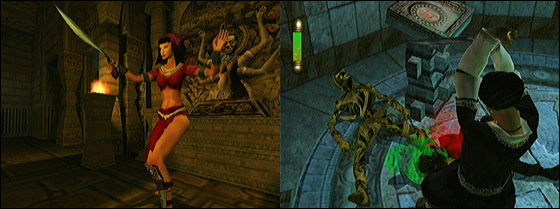
In respect to just the combat itself, the chapters affect the weapon selection, therefore the player is often changing their loadout between guns to swords, daggers and axes. Enemy types too add a little bit of variety, but there’s only a handful. Spells can also be used offensively, for example to power up weapons or cast protective walls.
As we can see, the individual parts are constructed and spliced in with the rest of the game in a way that conceals their shortcomings. The combat by itself isn’t very interesting, neither are the fetch quests or rubbing random objects against one another, but sliced and diced with other elements and the mechanics are fine. There isn’t anything inherently fun about the game, a talking point that I’d like to address (generally) in a later article.
As for the construction of the puzzles (yes, I totally digressed from my intended point for this heading, but it all times back in together in the end) most are find this, run there, run here, flick this sort of affairs and to be quite honest, there isn’t much to discuss as the simplicity of the puzzles only becomes apparent if you’re paying a lot of attention, like myself. The puzzles are neither “good simplistic” or “bad simplistic”, they’re mostly just unapparent to the player as like everything else, they’re integrated well with the other ingredients. That is, the simplicity of a run here, do that puzzle doesn’t become relevant to the player when you’re clearing zombies, casting spells and watching cutscenes in between.
The Evaluation
As we can see, Eternal Darkness is a context-rich game with a wonderful narrative, a demonizing camera and spooky music which conceal a set of mechanics that whilst decent, fail to stand on their own. These mechanics are organised in a way so that, for the most part, one element is never used enough to become uninteresting to the player. This isn’t a criticism, mind you, but rather a deconstruction of the fact that Eternal Darkness is driven by its narrative and atmosphere.
Next time we shall look at what happens when the equilibrium breaks and a single system is overworked.
Additional Readings
ZA Critique: Eternal Darkness: Sanity’s Requiem
Metroid Prime 3: Quarterly Diaries #13
November 20th, 2009

Areas Covered: Command Center (revisited, again)
Discussion Points: Command Station tutorial, Skyway Access set piece, Pirate Commander, Homeworld pacing
Command Center (revisited, again)
Here we are, back at the Command Center, re-equiped and ready to snuff out the rest of the map, again. We have almost all the tools we need, so on this third time around we can genuinely begin scouting out those hidden missile upgrades. I can’t help but feel a little betrayed that we’ve been teased by these upgrades a numerous times now.
At this point I’m also quite surprised at the length of the Homeworld area, which is probably 1.5 times the size of the other major planets. It’s just long enough that we won’t have the opportunity to cover the remaining sections in this article.
If we head back to Defense Access we can clear the phazon wall (continual practice of the new nova beam/x-ray visor combination) and finally disable the defense system, allowing that jerk-off Admiral Dane and his military men to storm the base. The room just behind the phazon wall, Command Station, is another good example of verticality used well. The room continues the tutorialization of the nova beam and X-ray visor, in a series of climbs and descents, up and down the spiral of platforms. The area is a tangled web and it’s often difficult to discern the next platform, pirate or phazon wall (the latter, part of the power down process). This environment encourages the player to switch between standard and X-ray visors to filter out the noise, whereby the X-ray visor identifies pirates and the elements within the phazon walls, and the standard visor makes it easy to discern the location of next platform. In this way, it teaches the player to operate rapidly between alternative states as the scenario becomes increasingly frantic.
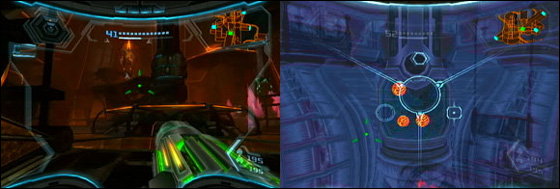
With the defence system disabled Skyway Access is taken off lockdown. The next objective is to rendezvous with Admiral Dane who is appropriately waiting there for us. When you arrive Dane will brief you on the situation before cowering away in his space ship. I’m not sure why, but the notion of this old dude bossing me around, in a Metroid game no less, is a strange anomaly, it just feels offensive. I preferred it when the Galactic Federation were in name only.
Dane equips you with 12 Demolition Troopers dressed in some pretty bad-ass suits. You’re objective is to escort the troops through to a security door which they can then put out of commission, leading the way for the final assault. The sequence is basically divided into a series of smaller sections where the player is given a handful of accompanying soldiers which they must defend, at each interval the soldiers switch up, the goal is to not lose too many of them along the way, however many is never specified.
This sequence seems to ape off the linear set pieces of games such as Call of Duty 4 or Halo. The inherent problem is that Metroid Prime is neither of those games, and whilst the action’s great (due largely to the motion controls and hyper mode mechanic), as a purist I can’t help but gawk at the idea a little. The pumped up music, transit trains which randomly pass through the environment and waves of pirates make it a pretty exciting sequence. There’s little time to fluff about, so hyper mode and the X-ray visor become crutches to lean on. You see, the X-ray visor also has the ability to zone in on the weak points of all enemies, more often than not the face, effecting nailing them in one go with a “head shot”. The sequence is basically a series of regular pirate confrontations, strung together over a few rooms and with a few added variables to watch over. I preferred in ingenuity of the vacuum sequence better myself, but both do well to elevate the action which seems only suitable given that we are in the space pirate’s central base.
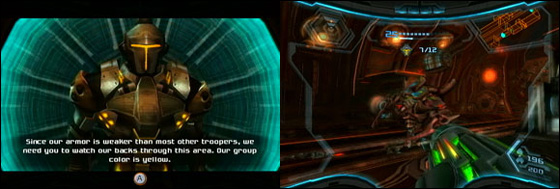
Once you’ve made your way on through, Samus runs into the ultra pink Pirate Commander, the final pirates defence. A series of close up shots in hyper mode make light work of the battle. The Pirate Commander warps between the two side platforms, and then hides behind cover once you’re in close proximity. He plays cheaply making it difficult to hit him. Because of this the player is forced to cheapen themselves too and hyper mode and the X-ray visor are made necessities. All the battle amounts to then is the player trying to land shots on the commander while maintaining enough distance in between before he teleports or hides behind cover. It feels like a rather cheap spectacle. Throughout the battle the player spends almost the majority of their tie in hyper mode, it’s disappointing then that the commander’s minions didn’t try to overload Samus with phazon. This would have likely made the battle more engaging, particularly if the commander joined in too and stopped hiding.
Once you’ve downed the commander, the arena opens up, allowing Samus to land her ship before heading directly to the seed. Before we get that far though I want to discuss the pacing of the Pirate Homeworld which can be documented as such:
Command Center, stealth sequence (linear) -> Research Facility, quiet sequence (linear) -> Elysia revisiting, shift of pace (planet swapping, Steam Lord branching) -> Research facility revisiting, quiet area becomes busy (open paths of entry) -> Command Center, front and backstage collide, Samus retreads the area out in the open (open entry points) -> Phazon Mining Site, setpiece battle climbs the pace (linear) -> Assault, action-heavy sequence (linear)
As we can see the pacing starts slowly in the backstage allowing Samus to expand her ability set before she knocks down the gates and storms the central base. This all comes to a head with a final confrontation with Ridley, which we’ll discuss in the next article.
Metroid Prime 3: Quarterly Diaries #12
November 17th, 2009

Areas Covered: Command Center (revisited), Phazon Mining Site
Discussion Points: “Sticky” map hints, purpose of mining site, Main Cavern set piece, nova beam
Command Center (revisited)
Surprisingly, the time spent back in the Command Center is reasonably short as you blow through a single line of defence (the voltage shield in the Command Courtyard) and cruise on through to another transit hub. Contrary to the little time that needs to be spent here, I actually wasted a lot of time unnecessarily exploring, thinking that I’d have a plethora of new rooms to explore with my updated arsenal, as well as being thrown off by another incorrect map hint.
This time the map prompts points you towards Skyway Access, yet once you arrive security kicks in, automatically placing the room on lockdown, enemies swarm in, a short battle ensues and then a morph ball tunnel diverts you back into a previously explored area (Defense Access). Actually, you’re suppose to use the spider ball to reach the transit station from Defense Access, but the map system keeps hinting you towards Skyway Access (which you must return to later), so like any good Metroid player I trusted what the game’s instructions and got screwed over for it, again!
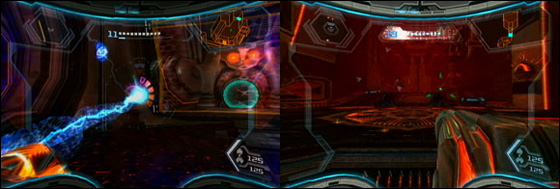
“Sticky” map hints have been discussed previously, and the solution to the problem is very easy: switch them off as soon as the player has entered the appropriate room, furthermore be more discreet in diverting the players attention towards the next, succeeding route. If a room is marked as a hint by the map and the player is required to first enter the room, leave and then return later with some other power-up, then the hints should bend to fit this situation (this has not been the case with the previously stated examples). From my experience, these minor annoyances can quite easily confound into a few hours of time-wasting. Not to downplay the criticism, but relatively speaking, they’re just minor blotches on a overly well paced game. Perhaps other players who don’t over-think things like me wouldn’t have succumb to the same pitfalls. I’m not sure, any comments folks?
Phazon Mining Site
The transit station takes us out to the Phazon Mining Site giving credence to the logbook entries earlier in the game and throughout Metroid Prime 2 where the pirates discussed their intersection with the hazardous catalyst. The Mining Site serves only to provide the player with the Nova beam, the final beam upgrade which will help open up the Skyway Access to lead the invasion a little later. It’s a short linear plough and just like the former sequence and the sequence which follows (an action-heavy set piece), the linearity is used to concentrate the pacing into a steady climb in preparation for the final set piece sequence.
In the first major room (Phazon Quarry) the player can use a touch pad to interface with a huge mining drill to clear a path. There are two areas that can be drilled and, as has been a reoccurring theme throughout the last few posts, either choice yields reward. There is no proper interplay between the player and the drill, making the sequence feel artificial.
Mine Lift, the following room, has Retro again playing with verticality in a well stylized manner. We’ve seen similar sequences before on Elysia and in the Imperial Caverns. Phazon Harvesting, the room just after it sees a little more experimentation too, this time with a Phazon Harvester dealing out massive damage through a pulse beam destined to send you off the narrow set of platforms.
The following section may be difficult to picture if you haven’t played this sequence before, the tail end of this video features the sequence in question. Mind the commentary.
When you reach the Main Cavern you arrive on an upper floor viewing platform overseeing a circular chamber glassed off in the centre. Functionally every room within the mine corresponds to the mining of Phazon ore, the circular room in this case acts as a giant suction tank for the ore chiseled-off from the perimeter outlined with phazon rock. Basically, the pirates chisel away at the walls for a minute or so, an alert signals, handrails rise up from the ground so that the pirates can stay grounded while the suction is taking place. It’s a somewhat unsafe work practice, but the premise makes for one of the most clever set pieces moments in the trilogy yet.
When the player enters the central room, the doors quickly closed off, pirates flood in and four totem poles raise from the floor, ostensibly it’s another clichéd run-in with the pirates. In this state the room acts as something of a stadium for a spectator sport. There’s tunnels for combatants to file in, a viewing platform for onlookers and an arena in which—through the raised totem poles—creates an interesting target/prey dynamic. Trusting my familiarity with the series I safely assumed that once I’d cleared the four initial pirates, everything would be over. After four or five waves of pirates and my first confrontation with the game over screen, I realized this wasn’t the case.
A minute or so into the battle, each of the pirates will rush to one of the four respective sets of handrails and, as mentioned before, the vacuum will begin it’s suction, drawing Samus into the centre and damaging her if she succumbs to the pressure. It’s in these sections where the player must push against the force whilst simultaneously shooting the pirates in an attempt of throwing off their grip and sending them into the vacuum, thereby revealing four weak points which the player can chip away at.
This binary construction creates an engaging attack/defend dynamic between the two states. In the initial state, with totem poles raised, the player must defend themselves from the pirate onslaught whilst at the same time weakening them in preparation for the next phase. If the player becomes too hasty and preemptively kills (!?) a pirate, another one will shuffle in, taking it’s place. It’s integral then that the player finds a steady balance between attacking and defending. The arena is constructed in a such a way—totem poles provide temporary but never full protection from the onslaught and the AI is smart enough to flush you out, forcing the player to constantly adapt to the shifting situation—that it constantly demands the player’s attention.
The second phase inverts the roles of the combatants in this stadium of ours, continually feeding into the attack/defend dynamic. This time, the player’s role is switched and the offensive takes the priority, although defence against the vacuum is still very important. The pirates are vulnerable and the player is free to weaken their grip (no health=loss of grip), yet the player must also be cautious of the inwards pull and at all times have their left thumb pushing the control stick in the opposite direction of the force.
As you can see, the gameplay throughout this sequence is engaging by the way the arena design, enemy AI and vacuum mechanic are constructed to have the player move between roles supporting polar mixes of offence and defence, both of which are dynamic and multifaceted.
Your reward for this area is the Nova beam and the trek to the landing zone from which we can fly back to the Command Center works as a tutorial for this device. The beam works with the X-ray visor to shoot out weaknesses in phazon walls, it’s a nice way to unify the two mechanics, especially considering that the ice and fire properties have already been covered. The beam is also considerably more powerful than the last.
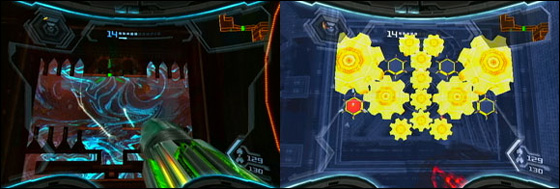
I also noticed that the alarms throughout the Pirate Homeworld pass on from room-to-room Metal Gear 2 style, whereas this may have not been the case in the previous two games. Not sure if my memory serves me well there.
Lastly, it’s somewhere around this part of the game that the log book scans continue to delve into the backstory of trilogy, leading right into the events on Norion, Bryyo and Elysia.
Additional Readings
The Most Stunning Metroid-Inspired Artwork



 Game Design Companion: A Critical Analysis of Wario Land 4 - $7.99
Game Design Companion: A Critical Analysis of Wario Land 4 - $7.99 Level Design: Processes and Experiences
Level Design: Processes and Experiences Speed Boost: The Hidden Secrets Behind Arcade Racing Design - $5.99
Speed Boost: The Hidden Secrets Behind Arcade Racing Design - $5.99 Adventures in Games Analysis: Volume I - $5.99
Adventures in Games Analysis: Volume I - $5.99







